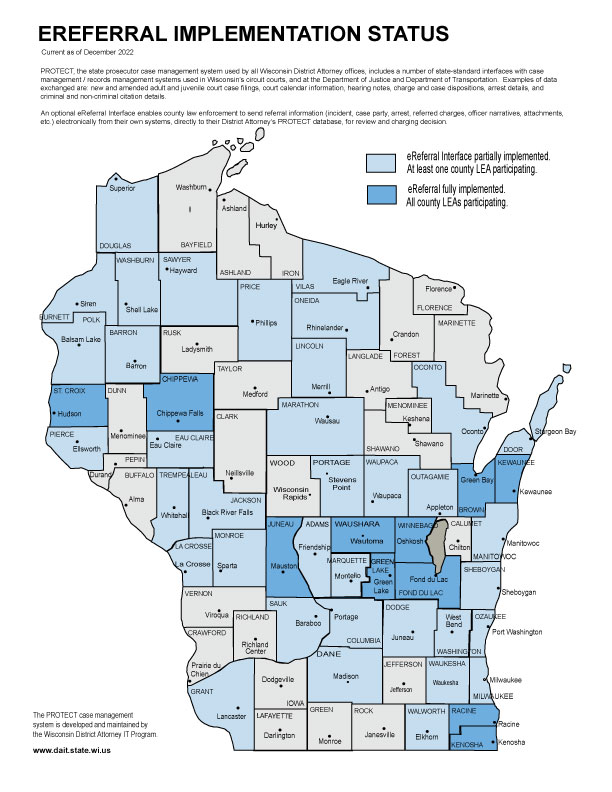Rather than manually delivering referrals to DA offices on paper, Wisconsin law enforcement and all circuit courts can transfer that same information digitally. And rather than manually entering that information into their case management system, DA offices can review the information on-screen and accept it into PROTECT to create a new or append to an existing DA case.
A combination of interfaces between PROTECT and other justice partner case management systems makes three types of electronic referrals possible.
Contested citations
State standard / included with PROTECT for all DA offices.
Sent to PROTECT through the existing interface with the case management system used in all Wisconsin circuit courts, which was created and is managed by the Wisconsin Circuit Court Access Program, or CCAP.
Includes non-criminal traffic and other fine/forfeiture-type citations.
In most Wisconsin counties, these matters are referred directly to the circuit courts by law enforcement, with the DA involved only if/after the defendant pleads Not Guilty at their initial appearance.
When the court case, already opened in the court's system, is updated to reflect this NG plea and the DA office as the prosecuting agency, the matter is electronically sent/referred to PROTECT.
Sent information includes person demographic and identifier information, citation and statute details, and the court case number generated from the court's CMS.
The DA office accepts this referral into PROTECT, a DA case is automatically created, and the resulting DA case number is immediately sent to the court's CMS. With each system now updated with the other's case number, information such as court appearance date/time/location, judge and defense attorney assignments, hearing notes, charge dispositions, and ultimately case dispositions are sent from the courts to PROTECT.

eCitations
State standard / included with PROTECT for all DA offices.
Sent to PROTECT from the Wisconsin Department of Transportation’s TraCS (Traffic and Crash) software, which is used by all Wisconsin State Patrol and almost all Wisconsin law enforcement agencies for issuing traffic citations, warnings, and recording crash data.
Criminal and non-criminal traffic-related citation
The referring agency must use the TraCS software and be enabled by the DOT to submit this data electronically.
eReferrals
Sent to PROTECT only from the records management systems (RMS) of participating law enforcement agencies.
Voluntary. Available on request from DA offices, with buy-in from interested law enforcement agencies in their county.
Sometimes called "true eReferrals", they include criminal and non-criminal new case referrals and supplemental attachments to previously referred charges.
Data transmitted is the same information commonly included in paper referral packets, most of which is maintained within the agency's RMS. This includes:
Incident date, time, location
Defendant demographic, identifier, alias, contact information
Victim and/or witness demographic, identifier, alias, contact information
Referred charges, enhancers, modifiers
Arrest date, agency, arrest tracking number (ATN)
Photos, attachments, supporting documentation
Officer narratives and any notes or incident reports
eReferrals may come from any number of law enforcement systems as long as the data from that system can be sent via the eReferral Interface, which uses the Global Justice XML Data Model (GJXDM) developed by the US federal government for the exchange of information within the justice and public safety communities.
Interested law enforcement agencies or IT professionals within those agencies, can find technical specs and the GJXDM subset below:
Interested DA offices can share this page with their agencies, then contact the DAIT helpdesk to initiate a conversation.
There is no requirement for any DA office to move away from paper and to eReferrals, but there are benefits.
There is no charge to DA offices who wish to transition to eReferrals. Agencies will need to work out costs with their RMS vendor.
DAIT can answer questions from agencies and RMS vendors' IT staff and will also help set up, test, and implement. DAIT analysts provide eReferral training to DA office staff.